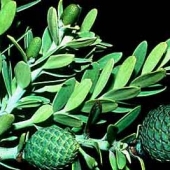Please select root levels for the menu
NZ Plants
Prumnopitys taxifolia - mātaī, black pine
Podocarp family: Podocarpaceae
-
Branch
L Jensen
View picture -
Stem, upper surface
I Macdonald
View picture -
Stem, lower surface
I Macdonald
View picture -
Juvenile plant
I MacDonald
View picture -
Juvenile scale leaves
L Jensen
View picture -
Terminal spikes bearing pollen cones
L Jensen
View picture -
One spike with 20-30 pollen cones
View picture -
Pollen cone scales with pollen sacs
L Jensen
View picture -
Each seed cone consists of an elongated spike bearing 4-12 ovules.
L Jensen
View picture -
Cone scale with inverted ovule
L Jensen
View picture -
Developing seed with green epimatium covering that is becoming fleshy.
L Jensen
View picture -
Mature seed with fleshy purple epimatium covering.
L Jensen
View picture
Prumnopitys taxifolia is a tall forest tree with dark green linear leaves that differ from those of miro in that they are are straight and not curved and are arranged into irregular and not flattened rows. The bark is easily distinguished by its thick multi-coloured flakes. Small, fleshy cones are formed. Initially the ovule is covered by an integument and a thin epimatium (derived from the seed scale) but after fertilisation the epimatium develops into a fleshy tissue ensheathing the ovule to the inside.
Formerly known as Podocarpus spicatus.
An endemic species found throughout New Zealand.
Vegetative characteristics |
Reproductive characteristics |
|---|---|
Adult plant form: tree up to 25 m |
Pollen and ovule cones: on separate trees |
Adult leaf form: flattened, straight and taper to a dull point; white on underside |
Pollen cone: in groups of 10-15 on a fertile stem (spike); each cone is 5-10 mm long with10-30 scales |
Adult leaf size: 10-15 x 1-2 mm |
Ovule cone: 40-60 mm long fertile stem with 3-12 fertile scales each bearing an ovule, and several sterile scales and bracts below |
Adult leaf arrangement: spirally arranged and spreading |
Ovule cone position: in axils of leaves |
Juvenile plant form: bushy tree with interlacing branching (divaricating ); persists for up to 50 years |
Ovule coverings: an inner covering (integument) and an outer covering (epimatium) ensheathing the ovule |
Juvenile leaf form: scale-like to linear and flattened, sharp tipped and spreading |
Ovule pore (micropyle): directed downward |
Juvenile leaf size: scale leaves 3-5 mm; spreading leaves 5-10 mm long |
Mature seed cone: a slender stalk bearing several, 6-10 mm diam. seeds each with a hard woody seed coat (integument) and a purple fleshy covering (epimatium) |
Juvenile leaf arrangement: interlaced stems with sparse scale leaves; tips of stems with longer spreading leaves, flattened in two rows |
Stem(receptacle) below seed: cone stalk is not fleshy |




